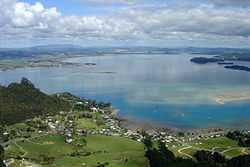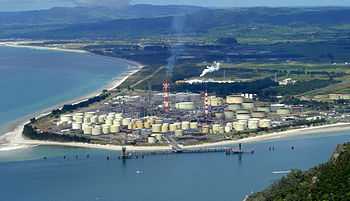Whangarei Harbour
| Whangarei Harbour | |
|---|---|
 | |
 Whangarei Harbour | |
| Coordinates: 35°48′S 174°25′E / 35.80°S 174.41°E | |
| Area | |
| • Total | 101.48 km2 (39.18 sq mi) |
Whangarei Harbour is a large harbour on the east coast of the North Island of New Zealand.
The harbour stretches from Whangarei City, and the termination of the Hātea River, south east around the Onerahi peninsula and out to the Pacific Ocean at Whangarei Heads.
Its name means "the place where whales gather" in Maori language.
History

Many early settlers and Maori used the harbour as a form of transport, and this played a large role in the establishment of Whangarei, and many of the industries in the area. These include Portland Cement Works, Marsden Point Oil Refinery and for the extraction of coal from Kamo.[1]<br/ >
From 1911-1933 the Onerahi Branch Railway crossed the upper reaches of the harbour to provide rail access to a new wharf built at Onerahi, as the existing wharf in the town basin was unreachable for some craft. This further promoted the harbour as an important feature to the development of Whangarei. <br/ >
In 2006, two marine reserves where opened in Whangarei Harbour. One is located in an inter-tidal area between Onerahi and Waikaraka, and another around Motukaroro Island, at Reotahi, Whangarei Heads. The Motukaroro Island reserve is popular with snorkelers due to the high amounts of marine life that can be seen there. [2]
<br/ >
Geography
Whangarei Harbour stretches approximately 23 km north-west from Whangarei Heads to its farthest point inland at the town basin in Whangarei central. At its widest point it is approximately 6 km wide, between Parua Bay and Takahiwai, near One Tree Point.[3] However, the harbour is heavily tidal with a tidal range of approximately 2m,[4] with much of the harbour being shallower than this in the wider parts. This means during low tide much of the harbour is mud flats and exposed sand bars. However, at the harbour entrance, where it is only around 800m wide, and between Onerahi and Matakohe Island, where it is only around 500m wide, it is much deeper and faster flowing than other areas of the harbour. This allowed for the deep water port to be built at Marsden Point and for the former ports at Whangarei and Onerahi to be located so far into the harbour.
The main rivers flowing into the harbour are Hātea River, Mangapai River, Limeburners Creek, Raumanga Stream and Otaika Creek.
Southern Right Whales used to gather in the harbour historically, but today small cetaceans such as dolphins and Orca, the Killer Whales can be observed in the harbour.
See also
- Whangarei Harbour Marine Reserve
- Whangarei Heads
- Matakohe Island, a large limestone island located in the Harbour.
- Mangapai River
- Hātea River